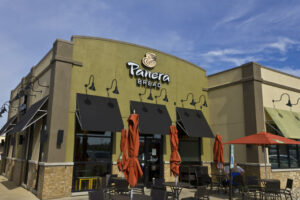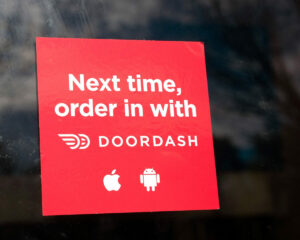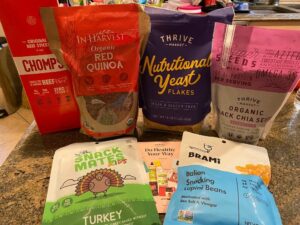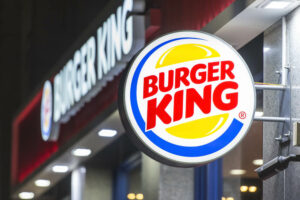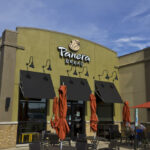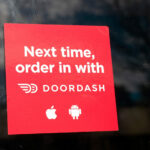Whether you’re a single millennial who only shops for the bare essentials or a passionate cook with three hungry children, you’re selling yourself short by not having a credit card that awards a high cash back rate on grocery purchases.
In 2020, the average American household with children under 18 spent over $8,000 on groceries, while those with no kids still racked up $5,500 in grocery bills. With food prices soaring, these figures are expected to rise in 2022.
The good news is that a lot of credit cards offer solid grocery cash back rates. The bad news is that A LOT of credit cards offer solid grocery cash back rates, and there is no catch-all “best” card for everyone. It really depends on your specific grocery spending, what else you spend on, and where you shop.
So that’s why instead of providing a generic list of the best grocery credit cards, we looked at several different scenarios. This is what we found.
Best credit cards for groceries on a $2,500 annual budget
Small spenders are going to have a difficult time earning enough cash back to justify cards with high annual fees. Luckily today’s market is ripe with decent grocery cards that don’t cost a dime to own.
- Winner: Citi Custom Cash
- Runner-up: American Express Blue Cash Everyday
- Best for travelers: American Express Everyday
Best grocery credit cards - $2,500 budget
| Credit Card | Annual Fee | Cash Back | Value (p/y) |
|---|---|---|---|
| Citi Custom Cash | $0 | 5% | $125 |
| AmEx Blue Cash Everyday | $0 | 3% | $75 |
| CP SavorOne Rewards | $0 | 2% | $50 |
| AmEx Blue Cash Preferred | $95 | 6% | $55 |
| BoA Cash Rewards | $0 | 2%+ | $50+ |
| Chase Freedom Flex | $0 | 5% (when applicable) | $31.25 quarterly |
| AmEx Everyday | $0 | 2x | $100 - $120* |
*denotes points value if transferred to a travel partner
The best of the best: Citi Custom Cash
Relative newcomer Citi Custom Cash takes the top spot, with some caveats.
Custom Cash offers 5% cash back in your top spending category per month, up to $500 spend. If groceries are your top expense each month, then on a $2,500 annual budget you’ll earn $125 cash back. That’s tremendous for a card with no annual fee.
However, if you spend more on something else, like dining out or transit, then that becomes your 5% category and you’ll only earn 1% cash back on all other purchases, including groceries.
Users do not have to activate their 5% category. It automatically adjusts based on monthly expenditures from 10 eligible categories. Besides grocery purchases, other broad categories include restaurants, gas stations, select travel, and select streaming services.
Cash back is paid in the form of ThankYou Points and can be redeemed as a statement credit, direct deposit, or paper check at a rate of 100 points = $1. ThankYou Points can also be redeemed at select retail outlets (Best Buy, CVS), Amazon.com, and for gift cards or travel expenses.
Other great credit cards for budget grocery shopping
The American Express Blue Cash Everyday card is another solid option, offering 3% cash back on groceries purchased at U.S. supermarkets.
On a $2,500 budget, this works out to an extra $75 in your pocket each year. Cash back is returned as either a statement credit or can be exchanged for a gift card (min $25) or merchandise.
The card’s other perks aren’t exactly mind-blowing – 2% at gas stations and select department stores, and 1% on everything else. Not to mention, superstores and wholesale clubs like Costco and Sam’s Club are excluded from the 3% category.
However, the combination of 3% cash back on grocery spend (up to $6,000 annually, then 1%) and a 0% annual fee is a rare treasure.
Of course, if you’re not stocking up at home, it could mean that you’re big on dining out or ordering in. Here, it makes sense to find a card that offers multiple avenues to save on food purchases. Capital One SavorOne Rewards fits the bill.
This no-annual-fee card grants unlimited 3% cash back on broad dining categories (including delivery services, bars, lounges, and bakeries) and 2% on groceries. Other perks include 3% on entertainment, 1% on other purchases, and a generous 0% intro ARP for the first 15 months.
For someone who spends $2,500 on groceries, and another $2,500 on dining each year, SavorOne Rewards will kick back $125 as either a statement credit, check, or gift card (min $25). You can also use your earnings to pay for purchases at Amazon.com.
Best budget grocery credit card for travelers: American Express Everyday
Historically, travel cards rarely offered grocery shoppers much in the way of benefits. The onset of COVID-19, and the canceled travel plans that came with it, changed that to a degree. Now that things are returning back to normal, those added perks are beginning to disappear.
The Amex Everyday card continues to show grocery shoppers the love.
Everyday has no annual fee, offers 2x points on groceries, 1x points on other purchases, and has a unique characteristic where users earn 20% more points if they use their card 20 or more times a month, with certain exclusions.
Unlike Amex’s Blue Cash cards, which award a form of cash back, Everyday purchases generate American Express Membership Points, which can be highly lucrative if transferred to Amex’s travel partners.
Doing so will result in an average return of 2 cents per point, which translates to 4-4.8% on groceries. That’s a stronger rate than any other free card we’ve looked at, sans Citi Custom Cash.
4.8% on a $2,500 annual budget works out to $120 cash back – nearly as good as rotating category cards like Chase Freedom Flex, but with more flexibility as to where you can shop.
On the downside, doing anything but transferring Membership Rewards points to an AmEx travel partner is a disaster, with point evaluations ranging from a paltry 0.5 cents up to a mediocre 1 cent.
Best credit cards for groceries on a $5,000 annual budget
In this tier, cards with low annual fees become more viable, especially if you spend closer to $6,000 than $5,000.
- Winner: Citi Custom Cash
- Runner-Up: American Express Blue Cash Preferred
- Best for frequent travelers: American Express Everyday Preferred
Best grocery credit cards - $5,000 budget
| Credit Card | Annual Fee | Cash Back | Value (p/y) |
|---|---|---|---|
| Citi Custom Cash | $0 | 5% | $250 |
| Amex Blue Cash Preferred | $95 | 6% | $205 |
| Amex Blue Cash Everyday | $0 | 3% | $150 |
| Chase Freedom Flex | $0 | 5% (when applicable) | $62.50 quarterly |
| AmEx Everyday Preferred | $95 | 3x | $300 - $450* |
*denotes points value if transferred to a travel partner
The best of the best: Citi Custom Cash / Amex Blue Cash Preferred
Folks spending about $100 a week at the grocery store have a few good options, but Citi Custom Cash is still top dog.
On a $5,000 budget, users will generate up to $250 cash back. However, those who spend a little bit more, or who have monthlky grocery bills that sometimes exceed $500 may want to consider American Express Blue Cash Preferred.
This card offers an unprecedented 6% back on groceries, up to $6,000 a year (1% after). There is an annual fee to contend with, but it’s small enough ($95) that moderate spenders will be able to offset it quite easily.
Spending $5,000 at U.S. supermarkets (remember superstores and wholesale clubs are excluded), will yield a $205 return, which is a cash back rate of 4.1%. Kick it up to $6,000, and the cash back rate maxes out at 4.42%.
Since Blue Preferred is a cash back and not a points card, all redemptions, whether they be statement credits, gift cards, or merch, are done on a 1:1 basis.
Other perks of the card include 6% on streaming, 3% on gas and transit, and 1% on other purchases. These numbers are so strong that non-travelers could pair Blue Cash Preferred with just one other card to fill in the gaps and call it a day. Chase Freedom Unlimited is a strong complementary card, since it covers dining (3%) and every day (1.5%) categories nicely, and doesn’t charge an annual fee.
Blue Cash Everyday is still a viable option at the $5,000 level and becomes especially handy if you cross the $6,000 grocery cap on Blue Cash Preferred.
Unfortunately, not many other non-travel cards offer shoppers in this tier a great return, with Chase Freedom Flex (when it features grocery as a 5% category) and store-specific cards like Chase Amazon Prime Rewards being situational exceptions.
Best for frequent travelers: American Express Everyday Preferred
American Express Everyday Preferred is an excellent low-budget option for those looking to allocate their grocery rewards toward travel. It offers 3x points at U.S. supermarkets, and kicks that up to 4.5x if you use the card 30 or more times a month, an increase of 50%.
The card has a few other perks as well, including 2x points at U.S. gas stations, 1x points on other purchases, and best of all, access to American Express’s transfer partners. All this for a $95 annual fee, which is exceptionally low for a points card.
The big drawback of this card and its little sister the American Express Everyday is that neither offers point multipliers on airline, hotel, or transit purchases. So initially it may seem odd that we appointed them as the best grocery cards for travelers. Don’t worry, we have our reasons, and the primary one revolves around how AmEx Membership Rewards points are evaluated.
We estimate that each point is worth approximately 2 cents when transferred to one of AmEx’s 18 travel partners. That means, for every $1 spent on groceries, you’ll earn approximately 6% back on transfer partner flights, or 9% if you make 30 or more purchases per month with Everyday Preferred.
Check out a full listing of AmEx’s travel partners here.
Note: AmEx Everyday and Everyday Preferred both cap their point multipliers on grocery spend at $6,000 annually. If you spend a lot at supermarkets, it pays to have both.
Best credit cards for groceries on a $10,000 annual budget
At the $10,000 tier, maxing out cash back on grocery purchases will require a bit more planning, especially for non-travelers who will benefit more from a multi-card strategy.
- Winner: A combination of high value grocery credit cards
- Best for frequent travelers: American Express Gold
Best grocery credit cards - $10,000 budget
| Credit Card | Annual Fee | Cash Back | Value (p/y) |
|---|---|---|---|
| Citi Custom Cash | $0 | 5% | $340 |
| AmEx Blue Cash Preferred | $95 | 6% | $305 |
| AmEx Blue Cash Everyday | $0 | 3% | $220 |
| Chase Freedom Flex | $0 | 5% (when applicable) | $75 quarterly |
| Discover it | $0 | 5% (when applicable) | $75 quarterly |
| American Express Gold | $250 | 4x | $550* |
*denotes points value if transferred to a travel partner
The best of the best: A menagerie of credit cards
Technically, Citi Custom Cash offers heavy grocery shoppers the best value ($340 cash back on $10,000 grocery spend). However, users in this category are well advised to mix and match.
Pairing Custom Cash with Blue Cash Preferred is a strong option. A user who charges $6,000 annually on Blue Cash Preferred, and then another $4,000 annually (capped at $500 per month) on Citi Custom Cash, will earn $560 in cash back, and $465 after annual fees. This works out to an effective cash back rate of 4.65%.
Users can also mix and match other cards with either Custom Cash or Blue Cash Preferred. For instance, you can weave in Chase Freedom Flex card when it offers 5% cash back on either a broad grocery category or at a store that sells groceries, like Walmart or a wholesale club. Just remember, that your 5% cash back is capped at $1,500 per quarter.
Discover it is another no-annual-fee categorical card that tends to offer 5% cash back on groceries at least one quarter per year. Also, it typically fits Walmart, Amazon.com (Whole Foods), and wholesale clubs into its calendar.
Unlike Freedom Flex, Discover it enables customers to plan ahead, as its 5% Calendar displays all upcoming categories for the current year.
This card is particularly potent for new registrants, as Discover will match all cash back earned during your first year, ramping up that 5% cash back to 10%.
If you’ve managed to exhaust all of these options, then you can either fill in the gaps with Blue Cash Everyday or a store-specific card like Amazon Prime Rewards, or the Capital One Walmart Card.
One strategy might look like this:
- $6,000 on American Express Blue Cash Preferred ($265 cash back after annual fee, 4.42%)
- $1,500 on Chase Freedom Flex when the grocery category is active ($75 cash back, 5%)
- $1,500 on Discover it when the grocery category is active ($75 cash back, 5%)
- $1,000 on American Express Blue Cash Everyday ($30 cash back, 3%)
Tally it all up and you’ve earned $445, or an effective cash back rate of 4.45%.
Best for frequent travelers: American Express Gold
When it comes to travel cards for folks with high grocery spend, there’s no better option than American Express Gold.
Although it’s advertised primarily as a mid-tier travel card, Gold is a bit of everything. Beginners will love it because it eliminates the need to devise robust credit card strategies and carry multiple cards, while pros recognize its inordinately high value.
Fair warning, this card does carry a $250 annual fee, so it’s not for families that won’t make good use of its myriad benefits, which include:
- 4x points on U.S. supermarkets, up to $25,000 annually
- 4x points on restaurants and dining worldwide, including takeout/delivery
- 3x on flights – direct bookings and bookings through amextravel.com both qualify
- 1x all other purchases
- $10 monthly credit on UberEats or Uber rides purchases.
- $10 statement credit on Grubhub, Seamless, and other qualifying restaurant purchases.
- 60,000 point bonus for new members that spend $4,000 on purchases within their first 6 months
Assuming that each point is worth an average of 2 cents when transferred to one of AmEx’s travel partners, grocery spenders will net 8% back on travel, virtually uncapped. Factor in the 4x dining perk (uncapped), and the two $10 monthly credits, and Gold is a foodie’s delight.
And yes, AmEx Gold is now also available in Rose Gold.
The main drawback, and it’s a significant one, is that Membership Rewards conversion rates on anything other than transfers are pretty abysmal. To wit, 1 point is worth:
- 0.7 cents at most retailers
- 0.5 – 1 cent when exchanged for gift cards
- 0.6 cents when used to cover your card charges
- 1 cent on flights booked through the American Express Travel portal.
It’s bad, so bad that the only condition in which we can recommend this card is if the points are going to be transferred to a travel partner. And in that case, it’s recommended wholeheartedly.
Best situational credit cards for groceries purchases
A few cards offer an incredible cash back rate on groceries, but only when a specific condition is met.
Best categorical grocery card: Chase Freedom Flex
We’ve mentioned Chase Freedom Flex a few times in this post, highlighting its situational use as a grocery card. Let’s dive a bit deeper.
Over ten quarters spanning from 2020 to mid-2022, Chase Freedom Flex offered the following bonus categories:
- Q1 2020: Gas stations, cable/internet/phone, and streaming services
- Q2 2020: Grocery stores, gym memberships, fitness clubs, and streaming services
- Q3 2020: Amazon.com and Whole Foods Market
- Q4 2020: Walmart and PayPal
- Q1 2021: Wholesale clubs, cable/internet/phone, and streaming services
- Q2 2021: Gas stations, home improvement stores
- Q3 2021: Grocery stores, select streaming services
- Q4 2021: Walmart and PayPal
- Q1 2022: eBay, grocery stores
- Q2 2022: Amazon.com and select streaming services
Notice a trend? During seven out of these ten quarters, Chase offered 5% cash back on at least one store where you can stock up on groceries. Now, not everyone wants to shop at Whole Foods or Walmart exclusively, but there should be at least one quarter per year when Freedom Flex will come in handy.
Remember, the best pure grocery card we’ve spoken about Citi Custom Cash) offers a maximum effective cash back rate of 5%, and only up to $500 a month. Freedom Flex matches that.
Flex really “flexes” its muscles when paired with either Sapphire Preferred or Sapphire Reserve. This will enable you to convert your cash back to Ultimate Rewards points, which have an average value of over $0.02 when transferred to Chase’s travel partners, for an effective rate of 10% back on 5% category spend.
In addition, simply using the Chase travel portal will see your points pumped up by 25% (Preferred) or 50% (Reserved) when making purchases.
Factor in the continuous 5% cash back on travel purchased through Chase, 3% cash back on dining/drugstores, and no-annual-fee, and Freedom Flex belongs in any serious grocery shopper’s wallet.
Best grocery credit card in a very specific situation: Bank of America Cash Rewards
If you just so happen to have an abundance of cash in either a Bank of America personal checking or Merrill investment account, then the Bank of America Cash Rewards card becomes a serious contender for best grocery card.
Even without any extra perks, BOA Cash Rewards is solid, offering 2% cash back on groceries and wholesale clubs, and 3% on a category of your choice, which includes:
- Gas
- Dining
- Travel
- Drug stores
- Home improvement/furnishings
The combined spend for both the 3% and 2% categories is capped at $2,500 per quarter, after which the rate drops to the standard 1%. All other categories also earn 1%.
Note: The fact that BoA doesn’t exclude wholesale clubs from its grocery list is a big plus, as most other issuers aren’t so generous.
The savings improve dramatically if you’re part of the Preferred Rewards program, as you’ll generate up to 75% more cash back. This works out to 3.75% on groceries, and 5.25% on a category of your choice. That’s absolutely insane for a no-annual-fee card, but earning membership isn’t exactly easy.
The entry-level (Gold) tier requires that you have a three-month rolling average of at least $20,000 in a Bank of America deposit and/or Merrill investment account. To fully max out, you’ll need to keep $100k or more stashed away, and that just isn’t realistic for most people.
| Preferred Rewards Level | Required Balance | 2% Category (Grocery/Wholesale) | 3% Category (Choice) | 1% Category (All other) |
|---|---|---|---|---|
| None | None | 2% | 3% | 1% |
| Gold | $20,000 - $49,999 | 2.5% | 3.75% | 1.25% |
| Platinum | $50,000 - $99,999 | 3% | 4.5% | 1.5% |
| Platinum Honors | $100,000+ | 3.5% | 5.25% | 1.75% |
Still, if you manage even the Platinum tier, you’ll be generating a continuous 3% back on grocery and wholesale club spend, and 4.5% on a category of your choosing. That’s a better combo than anything else in the no-annual-fee tier of cash back cards.
At Platinum Honors, BoA Cash Rewards really starts to shine. Check out how it stacks up against some of our favorite cash back grocery cards:
Bank of America Cash Rewards (Platinum Honors) vs. other grocery credit cards
| Credit Card | $2,500 Budget Cash Back | $5,000 Budget Cash Back | $10,000 Budget Cash Back |
|---|---|---|---|
| Bank of America (/w Platinum Honors) | $87.50 | $175 | $350 |
| AmEx Blue Cash Preferred | $55 | $205 | $305 |
| AmEx Blue Cash Everyday | $75 | $150 | $220 |
| CP SavorOne Rewards | $50 | $100 | $200 |
Now we’re not advising that you invest $100k at Bank of America just to get this card – far from it. But if you already have the money in there, pick Cash Rewards up.
When you can’t get enough of one store
So far, we’ve talked extensively about how nearly any shopper can earn between 3 – 4.5% cash back on grocery spend, simply by using the right credit cards.
Those that use the following stores exclusively can typically fare even better:
- Chase Amazon Prime Rewards: This card awards 5% on Amazon.com purchases, including Amazon Fresh and Whole Foods, uncapped. In addition, it kicks back 2% at restaurants, gas stations and drugstores, and 1% elsewhere. It doesn’t carry an annual fee, but you will need to have an Amazon Prime membership ($139 annually) to qualify. Points can be redeemed for Amazon purchases, cash back and gift cards at a 1:1 conversion rate, but not upconverted to Ultimate Rewards points.
- Capital One Walmart Rewards: This one is really only recommended for folks who use Walmart.com. Online purchases award 5% cash back, while in-store purchases only generate 2%. The 5% earnings are uncapped and there is no annual fee, but the other perks are underwhelming: 2% at restaurants and on travel, and 1% on everything else.
- Target RedCard: Instead of awarding cash back as a rebate, Target customers with this card will simply receive 5% off the top at checkout. The 5% discount applies to everyday shopping, in-store Starbucks, clearance, and select gift card purchases. Both in-store and online purchases are eligible, and free shipping plus an extended return period is included, with few exclusions.









